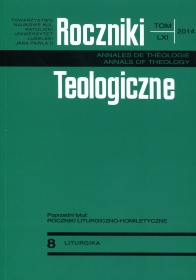Musical Culture of the Cistercians in Krzeszów in the 18th Century. Chosen Issues
Abstract
The beginnings of the Cistercian Abbey in Krzeszów go back to the end of the 13th century. The second half of the 17th century, that is the time of the rule of Abbot Bernard Rosa (1660-1696), may be considered a turning point in the history of the abbey. It was owing to him that the life of the abbey started to develop dynamically in many areas, including music that was an important element of the life of the abbey.
Music performed during the liturgy and services in Krzeszów was realized in two ways. On the one hand, monastery traditions of chorale singing were continued, and on the other, new tendencies of polyphonic music were introduced. Vocal-instrumental church music was a very distinct feature of the musical life of Krzeszów; besides, also instrumental music was performed. It was supposed to fulfill four basic functions: to be decorative (decoratio), to give the impression of pleasure (delectare), to stir up emotions (permovere) and to teach (docere). In the 18th century music performed in Krzeszów the concerting style was dominant.
The music performed in Krzeszów may be divided—on the basis of the preserved documents —into two fundamental categories: (1) works designed for the liturgy, and (2) ones performed outside the liturgy. These works were a manifestation of the main currents of the spirituality of the Krzeszów Cistercians: of the Christocentric current, expressed in services of adoration of the Holy Sacrament, in the passion cult, in the cult of Emmanuel (the Prague Christ Child), of the Mariological current and of the current of the cult of the saints (mainly of St Joseph, St John of Nepomuk, St Jadwiga and the Fourteen Holy Helpers). Part of the works were composed by native composers, often the Cistercians themselves, and the remaining ones – by foreign composers.
Music in Krzeszów was performed by the band that existed there. Its members were: cantors and successors, choirmasters, the so-called regentes chori, organists, and other musicians. Among them there also were composers and teachers, who taught young boys music and the liturgy in the local school.
Organs have always been an important element of musical culture of Krzeszów. In the Basilica of the Assumption of the Blessed Virgin Mary there are organs built in the years 1632-1639 by the Silesian organ builder. The instrument is unusually precious, among others due to its architecture and sound values. A considerable part of the original elements have survived till today. The other organ instrument in Krzeszów are organs in the Church of St Joseph. It is supposed that they were moved to the church from the Czech monastery in Břevnov. It is not known precisely when and in what organ workshop they were built.
References
Dębski P.: Przygotowanie i realizacja prac konserwatorskich przy zabytkowych organach Michaela Englera w bazylice p.w. Wniebowzięcia NMP w Krzeszowie. W: Organy Michaela Englera w bazylice p.w. Wniebowzięcia NMP w Krzeszowie. Red. P. Grinholc. Krzeszów: Diecezja Legnicka 2008 s. 5-13.
Górniak M.G.: Krzeszów. W: Encyklopedia Katolicka. T. 9. Red. A. Szostek, B. Migut. Lublin: TN KUL 2002 kol. 1447-1449.
Hołownia P.: Wielkie organy Michaela Englera Młodszego w Krzeszowie. W: Krzeszów uświęcony łaską. Red. H. Dziurla, K. Bobowski. Wrocław: Wyd. Uniwersytetu Wrocławskiego 1997 s. 321-330.
Kostrzański H.: Dziedzictwo białych mnichów. Szczyrzyc: Wyd. OO.Cystersów 1991.
Kozieł A.: Angelus Silesius. Bernhard Rosa i Michael Willmann, czyli sztuka i mistyka na Śląsku w czasach baroku. (Acta Universitatis Wratislaviensis. Historia sztuki. T. 23). Wrocław: Wyd. Uniwersytetu Wrocławskiego 2006.
Kudera D.: Krzeszów. Red. M. Malerek. Piechowice: Laumann-Polska 1997.
Pośpiech R.: Muzyka wielogłosowa w celebracji eucharystycznej na Śląsku w XVII i XVIII wieku. (Z dziejów kultury chrześcijańskiej na Śląsku nr 29). Opole: Redakcja Wydawnictw Wy-działu Teologicznego UO 2008.
Pośpiech R.: Wkład cystersów w rozwój kultury muzycznej Śląska. W: Johannes Nucius. Epoka, duchowość, życie i twórczość. Materiały z Konferencji Naukowej zorganizowanej z okazji 450-lecia urodzin Johannesa Nuciusa, opata cysterskiego w Jemielnicy, kompozytora i teoretyka muzyki. Kamień Śląski, 11 października 2006 r. Red. R. Pośpiech, P. Tarliński. (Z dziejów kultury chrześcijańskiej na Śląsku nr 46). Opole: Redakcja Wydawnictw Wydziału Teologicznego UO 2008. s. 185-212.
Tarliński P.: Teologiczno-estetyczne aspekty duchowości cysterskiej. W: Johannes Nucius. Epo-ka, duchowość, życie i twórczość. Materiały z Konferencji Naukowej zorganizowanej z okazji 450-lecia urodzin Johannesa Nuciusa, opata cysterskiego w Jemielnicy, kompozytora i teoretyka muzyki. Kamień Śląski, 11 października 2006 r. Red. R. Pośpiech, P. Tarliński. (Z dziejów kultury chrześcijańskiej na Śląsku nr 46). Opole: Redakcja Wydawnictw Wydziału Teologicznego UO 2008 s. 93-144.
Walter R.: Musikgeschichte des Zisterzienserkloster Grüssau. Von Anfang des 18. Jahrhunderts bis zur Aufhebung im Jahre 1810. Kassel–Basel–London–New York–Prag: Bärenreiter 1996.
Wolnik F.: Cystersi w Europie. W: Johannes Nucius. Epoka, duchowość, życie i twórczość. Materiały z Konferencji Naukowej zorganizowanej z okazji 450-lecia urodzin Johannesa Nuciusa, opata cysterskiego w Jemielnicy, kompozytora i teoretyka muzyki. Kamień Śląski, 11 października 2006 r. Red. R. Pośpiech, P. Tarliński. (Z dziejów kultury chrześcijańskiej na Śląsku nr 46). Opole: Redakcja Wydawnictw Wydziału Teologicznego UO 2008 s. 45-92.
Wolnik F. Charakterystyczne cechy liturgii cysterskiej. W: Johannes Nucius. Epoka, duchowość, życie i twórczość. Materiały z Konferencji Naukowej zorganizowanej z okazji 450-lecia urodzin Johannes Nuciusa, opata cysterskiego w Jemielnicy, kompozytora i teoretyka muzyki. Kamień Śląski, 11 października 2006 r. Red. R. Pośpiech i P. Tarliński. (Z dziejów kultury chrześcijańskiej na Śląsku nr 46). Opole: Redakcja Wydawnictw Wydziału Teologicznego UO 2008 s. 145-183.
Wolnik F.: Liturgia Śląskich cystersów w średniowieczu. (Opolska Biblioteka Teologiczna t. 52). Opole: Redakcja Wydawnictw Wydziału Teologicznego UO 2008.
Copyright (c) 2014 Roczniki Teologiczne

This work is licensed under a Creative Commons Attribution-NonCommercial-NoDerivatives 4.0 International License.





